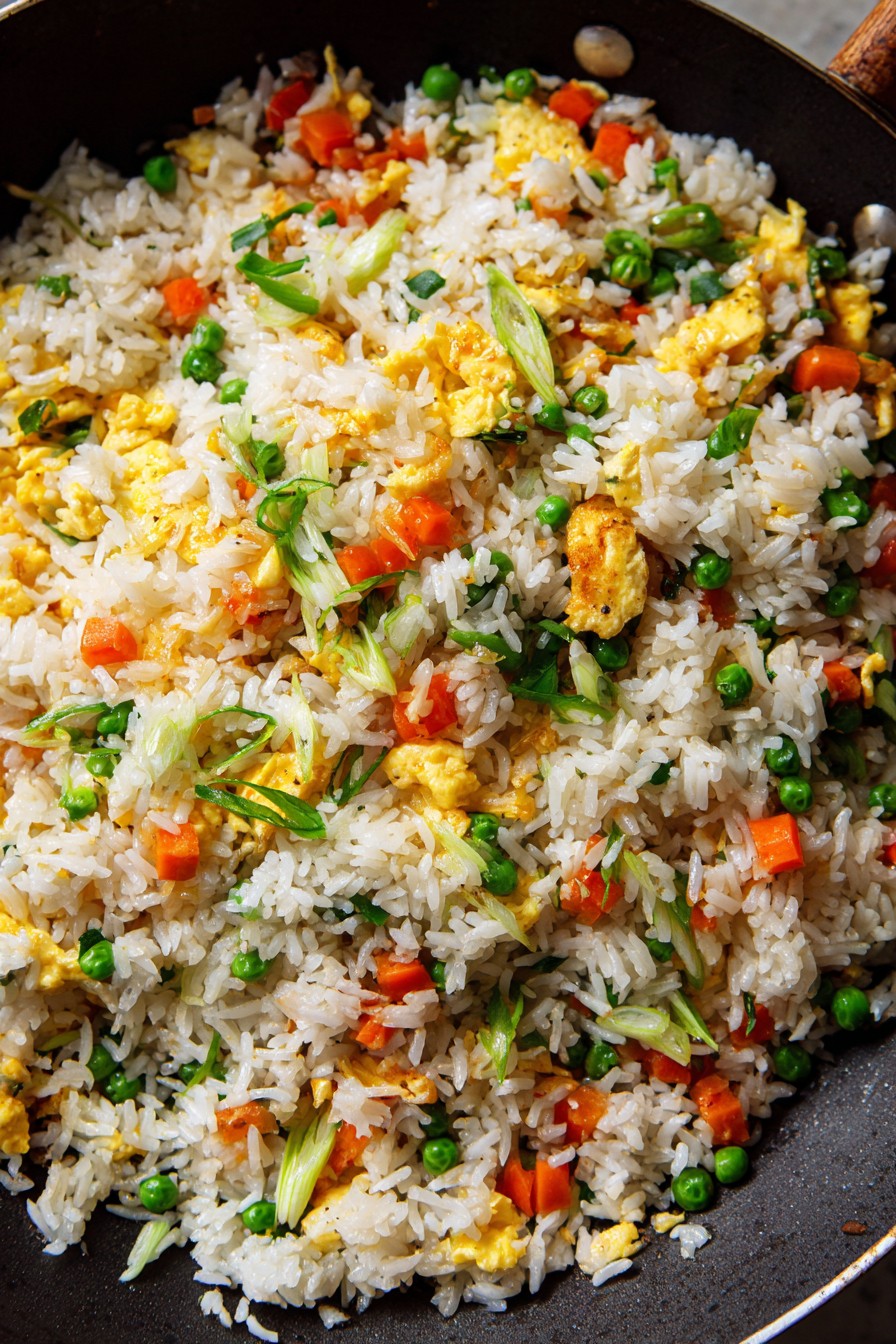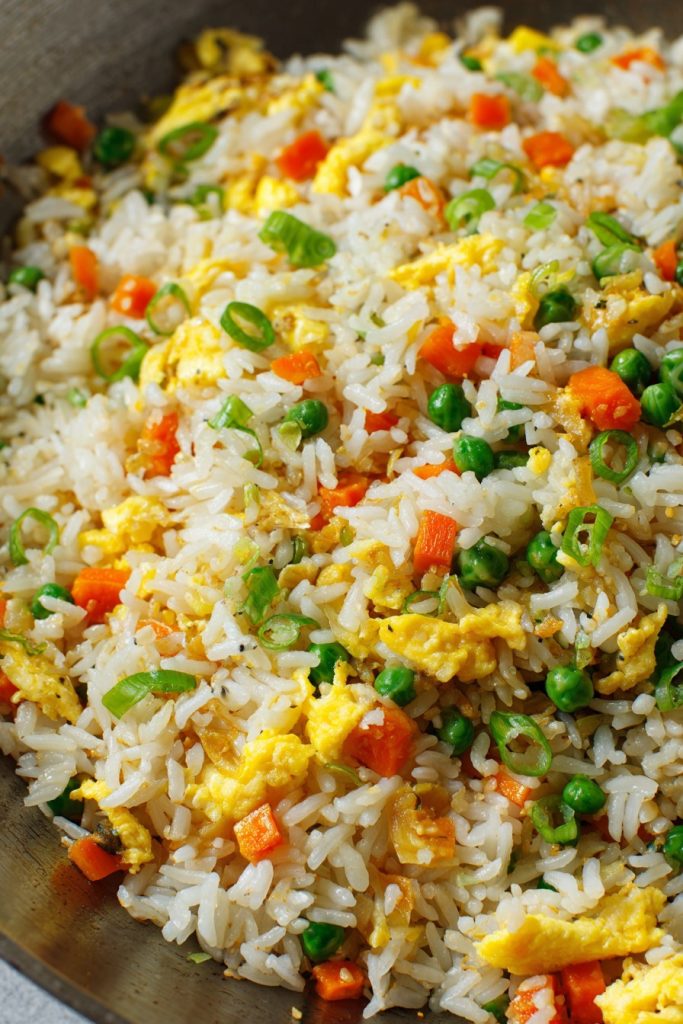Zestful and satisfying, this Chinese fried rice transforms simple ingredients into a complete meal. Zero fuss required for this adaptable dish that works with whatever you have on hand.
Why This Recipe Works
- Using day-old rice creates the perfect dry texture that fries rather than steams, preventing mushiness
- High heat cooking in batches ensures each ingredient gets proper sear and maintains texture integrity
- The scrambled egg technique coats rice grains evenly while adding protein richness
- Simple seasoning combination of soy sauce and sesame oil delivers authentic flavor without complexity
- Quick cooking method preserves vegetable crunch while developing wok hei aroma
Ingredients
- 3 cups cooked white rice, day-old and chilled
- 2 large eggs, beaten
- 1 cup frozen peas and carrots mix, thawed
- 1/2 cup yellow onion, finely diced
- 2 cloves garlic, minced
- 3 tablespoons vegetable oil, divided
- 3 tablespoons soy sauce
- 1 teaspoon sesame oil
- 2 green onions, sliced thin
- 1/4 teaspoon white pepper
Equipment Needed
- Large skillet or wok
- Wooden spatula
- Mixing bowls
- Measuring spoons and cups
- Cutting board and knife
Instructions

Prepare Ingredients and Pan
Measure all ingredients before starting since cooking happens quickly. Place beaten eggs in one bowl, thawed peas and carrots in another, and combine minced garlic with diced yellow onion. Have soy sauce, sesame oil, and white pepper measured and accessible. Heat a large skillet or wok over medium-high heat for 2 minutes until hot. Add 1 tablespoon vegetable oil and swirl to coat the surface evenly. Proper preheating ensures immediate sizzle when ingredients hit the pan, creating essential wok hei flavor. This preparation prevents scrambling during cooking and allows focus on technique rather than measurement.
Cook Eggs and Set Aside
Pour beaten eggs into the hot oiled pan. Let them set for 15 seconds without stirring, then use your spatula to scramble gently. Cook for 45-60 seconds until softly set but still slightly moist. Immediately transfer to a clean plate. The eggs will finish cooking later when combined with hot rice. This two-stage egg cooking prevents rubbery texture and ensures even distribution throughout the fried rice. Under-cooking at this stage is intentional since residual heat will complete the process.
Sauté Aromatics and Vegetables
Add remaining 2 tablespoons vegetable oil to the same pan. When oil shimmers, add diced yellow onion and minced garlic. Cook for 90 seconds, stirring constantly, until onions turn translucent but not browned. Add thawed peas and carrots mixture. Continue cooking for 2 minutes, stirring frequently, until vegetables are heated through and slightly tender but still crisp. The high heat should create some light browning on the onion edges. Tip: Frozen vegetables work better than fresh here because they contain less moisture that would steam the rice.
Combine Rice and Season
Add day-old rice to the pan, breaking up any clumps with your spatula. Stir constantly for 3-4 minutes until rice is heated through and grains separate. Create a well in the center and pour soy sauce directly onto the hot pan surface. Let it sizzle for 10 seconds before mixing thoroughly with the rice. This technique caramelizes the soy sauce slightly, deepening its flavor. Add white pepper and reserved scrambled eggs, breaking them into small pieces as you incorporate.
Finish and Serve
Drizzle sesame oil over the fried rice and mix well. Cook for one final minute, stirring constantly, to blend all flavors. Remove from heat and fold in sliced green onions. Taste and adjust seasoning if needed. Serve immediately while hot. The entire cooking process from first ingredient to finished dish should take under 15 minutes. Tip: Let the fried rice sit undisturbed for 1 minute before serving to allow the bottom layer to develop a slight crust.
Tips and Tricks
For optimal rice texture, spread freshly cooked rice in a thin layer on a baking sheet and refrigerate uncovered for at least 4 hours. This method dries the surface while keeping the interior moist. If you need day-old rice quickly, spread cooked rice on a parchment-lined baking sheet and freeze for 45 minutes, stirring occasionally. The freezing process removes moisture effectively without making the rice hard. When using a home stove, maximize heat by letting your pan preheat thoroughly before adding oil, then wait until the oil shimmers before adding ingredients. Work in batches if your pan crowds easily—overcrowding creates steam that makes rice gummy. For authentic restaurant-style flavor, consider adding a small amount of Chinese cooking wine during the soy sauce step. If you prefer darker fried rice, use dark soy sauce instead of regular, or combine both for complex color and flavor. Leftover fried rice stores well for up to 3 days in airtight containers. Reheat in a skillet rather than microwave to restore texture. For crispier rice, press it firmly into the hot pan and let it cook undisturbed for 60-90 seconds before stirring. This creates delicious browned bits throughout the dish. If using fresh vegetables instead of frozen, sauté them separately first to remove excess moisture before adding to the fried rice. Always have all ingredients prepped and within reach before turning on the heat, as the cooking process moves too quickly to pause for chopping or measuring.
Recipe Variations
- Protein additions: Incorporate 1 cup cooked shrimp, chicken, or pork added during the vegetable stage. For vegetarian protein, use cubed firm tofu pan-fried until golden before adding to the rice. Pre-cooked proteins work best to maintain proper cooking timing.
- Vegetable substitutions: Replace peas and carrots with 1 cup chopped broccoli florets, bell peppers, or mushrooms. Adjust cooking times accordingly—denser vegetables may need 1-2 extra minutes of sautéing before adding rice.
- Flavor twists: For spicy fried rice, add 1 teaspoon chili garlic sauce with the soy sauce. For Thai-style, substitute fish sauce for soy sauce and add basil leaves at the end. For Japanese chahan, use tamari and add a dash of mirin.
- Grain alternatives: Substitute brown rice or cauliflower rice for white rice. Brown rice may require 1-2 tablespoons additional liquid and longer cooking time. Cauliflower rice should be added at the final stage and cooked just until heated through.
Frequently Asked Questions
Can I use freshly cooked rice?
Freshly cooked rice contains too much moisture and will create mushy fried rice. The starch molecules need time to retrograde and firm up. If you must use fresh rice, spread it in a thin layer on a baking sheet and refrigerate for at least 2 hours. Some cooks rinse freshly cooked rice with cold water and drain thoroughly to remove surface starch, though this method is less reliable than using properly cooled rice. The ideal rice texture is separate grains that don’t clump together.
What type of rice works best?
Medium or long-grain white rice like jasmine or basmati creates the best texture. Short-grain rice like sushi rice contains more starch and tends to become sticky. Brown rice can be used but requires adjustment to cooking time and liquid. Regardless of type, the rice must be thoroughly cooled. Restaurant kitchens often par-cook rice specifically for frying, then cool it rapidly. For home cooks, leftover rice from yesterday’s dinner provides perfect consistency and makes efficient use of leftovers.
Why does my fried rice turn out soggy?
Sogginess typically results from three issues: using warm rice with excess moisture, overcrowding the pan, or insufficient heat. Ensure your pan is properly preheated before adding ingredients and work in batches if necessary. Another common mistake is adding too much sauce—the soy sauce should coat the rice lightly rather than pool in the pan. If vegetables release water during cooking, sauté them separately first and add back later. Proper technique involves constant stirring and high heat to evaporate moisture quickly.
Can I make this recipe vegetarian or vegan?
This recipe is easily adaptable. For vegetarian version, simply omit any meat and proceed as directed. For vegan preparation, omit eggs and increase vegetables or add tofu. Replace eggs with scrambled tofu using 1/2 block crumbled firm tofu cooked with 1/4 teaspoon turmeric for color. Check that your soy sauce is vegan—some brands contain fish products. Nutritional yeast can add savory depth if omitting eggs. The basic technique remains identical regardless of protein choices.
How do I achieve that restaurant-style smoky flavor?
The characteristic wok hei flavor comes from extreme heat causing slight caramelization and smoke. Home stoves can’t replicate commercial wok burners, but you can approximate it by ensuring your pan is very hot before adding ingredients. Let the soy sauce hit the hot pan surface directly before mixing with rice. A small amount of toasted sesame oil added at the end enhances the smoky notes. Some cooks briefly turn the heat to highest setting during the final minute of cooking to develop more browning.
Summary
This Chinese fried rice recipe uses simple techniques for authentic results. Day-old rice, high heat cooking, and proper ingredient sequencing create perfect texture and flavor. Customize with available proteins and vegetables for endless variations.
Chinese Fried Rice
5
servings10
minutes15
minutesIngredients
Instructions
- 1 Heat large skillet over medium-high heat. Add 1 tablespoon oil and scrambled eggs until softly set. Transfer to plate.
- 2 Add remaining oil to hot pan. Sauté onion and garlic for 90 seconds until translucent.
- 3 Add peas and carrots, cook 2 minutes until heated through but still crisp.
- 4 Add day-old rice, break up clumps, and stir 3-4 minutes until heated.
- 5 Create well in center, pour soy sauce directly onto pan surface. Let sizzle 10 seconds before mixing.
- 6 Add white pepper and reserved eggs, breaking into pieces. Drizzle sesame oil and cook 1 final minute.
- 7 Remove from heat, stir in green onions, and serve immediately.



